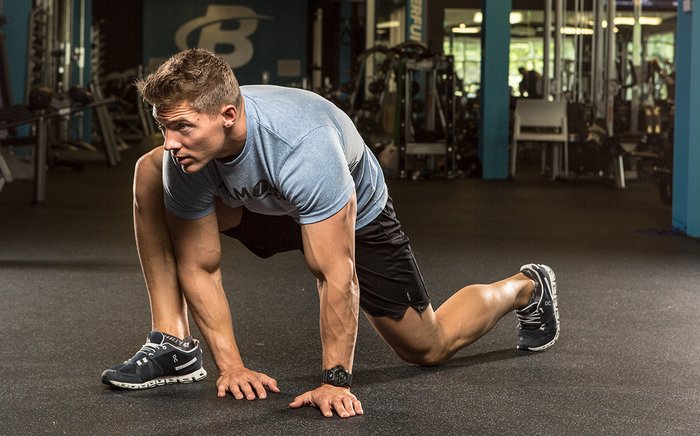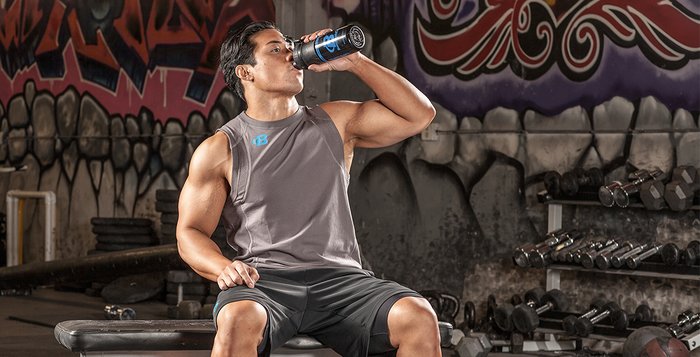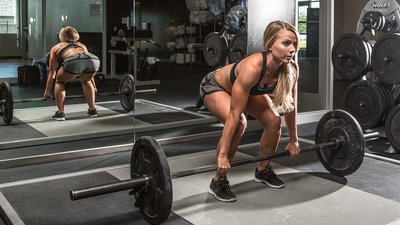DOMS: The dreaded four-letter word (well, technically it's an acronym, for "delayed-onset muscle soreness) that many a gym goers have a love/hate relationship with. We love it because it's a not-so-gentle reminder that we killed it in the gym. We hate it because it hurts to sit, stand, lay down, or sometimes even breathe.
First and foremost, it's important to understand that not all soreness is bad. Think of it as your body letting you know it's currently going through a repair process—and yes, the end result is bigger, stronger muscles. In order to see change within your muscles, you need to disrupt their structure. Unfamiliar or high-intensity exercise causes small microscopic tears within the muscle fibers, which creates a stimulus for muscle growth and repair. In other words, it is definitely part of the transformation process.
For this reason, many people find DOMS to be gratifying—to a point. For others, it can be enough to keep them out of the gym and off their routine. This is exactly what we don't want to happen to you!
Expect to experience some soreness when you start any new program, especially during the first couple of weeks while your body is becoming adapted to the training intensity and volume. After that, it will get better. Until then, make the best of a painful situation with these research-backed tips to speed up recovery!
Don't Skip The Warm-Up
Before you even think about picking up the weights, give your body a chance to loosen up. Even something as simple as walking or cycling for 10 minutes before you start your workout can significantly reduce perceived soreness in the days following your workout.[1]

Before you even think about picking up the weights, give your body a chance to loosen up.
Dynamic stretching is another great option to incorporate into your pre-workout routine. This form of stretching, which requires you to move as you stretch, helps to activate the muscles you will use during your workouts, while improving range of motion, balance, and coordination.
There are dozens of great dynamic warm-up moves you can mix and match. A few favorites include:
- Alternating knee pull
- Bodyweight reverse lunge
- Bodyweight single-leg deadlift
- Alternating glute pull-up lift
- The "world's greatest stretch"
You can also spend a little quality time with your favorite foam roller, which research has shown can enhance range of motion before training.
I also strongly encourage you to incorporate warm-up sets before each of your major lifts. Rather than jumping straight into your first working set, start with a few sets using lighter weights, and gradually work up to your first working set. This allows your joints to work through a full range of motion while also increasing blood flood and nutrient delivery to the working muscle groups.
Warm-ups sets also help to prime your nervous system so that the appropriate muscle fibers are firing. Just make sure you aren't taking your warm-up sets to failure.
Example warm-up set for squats:
- 1 set 10 reps at 50% of your working weight
- 1 set of 8 reps at 65% of your working weight
- 1 set of 4-6 reps at 80% of your working weight
Note: You can always include more warm-up sets before you start your first working set.
I don't suggest you do static stretching during your warm-up. Research has shown that including static stretching, in which you hold a specific stretch for a period of 10-30 seconds, during the first part of your workout can actually decrease power output and have a negative impact on how much weight you can load on the bar. Save the stretching for your cool-down.
Post-workout stretching can be used as a light cool-down. It won't help to reduce any next-day soreness or discomfort, but it can help to increase flexibility. Make sure you're holding each stretch for at least 30-60 seconds and hold each stretch at a point of mild discomfort.
Train Through Soreness
While it may sound counterintuitive, one of the best ways to resolve muscle soreness it to lightly train the muscles that are sore. Training while still sore from your previous workout can actually help to decrease future soreness and allow the body to adapt at a faster rate, a phenomenon known as the "repeated-bout effect."

While it may sound counterintuitive, one of the best ways to resolve muscle soreness it to lightly train the muscles that are sore.
Your body is designed to recover from microtrauma—in this case, small tears within the muscle fiber—and adapt so that the next time you perform the same workout, you'll experience significantly less DOMS.
This may be pretty uncomfortable, so don't be afraid to decrease the intensity or volume of your lifts. Just make sure you're going through full range of motion and keeping good form.
Take Recovery-Boosting Supplements
Supplements won't magically make your soreness disappear, but they can help minimize some of the pain and discomfort. For example, you could also opt for extra protein pre- and post-workout. Whey and casein are both great options to have before and after training to help speed up the recovery and repair process. Branched-chain amino acids have also been shown to reduce muscle soreness following high volume workouts.[2,3]
For those relatively new to the training game, there may be some benefit to supplementing with beta-hydroxy beta-methylbutyrate, better known as HMB. HMB is a metabolite of the amino acid leucine, and it appears to work by preventing the breakdown of proteins in the muscle. Because HMB helps to reduce exercise-induced muscle damage and assist in the repair process, you can expect some improvements in your strength and muscle mass when used in combination with a resistance-training program.

Supplements won't magically make your soreness disappear, but they can help minimize some of the pain and discomfort.
Keep in mind that you need to take HMB consistently for 28 days to optimally load the muscle and to get the most benefit out of the supplement.
Of course, we can't forget about fish oil. Studies have shown that supplementing with omega-3s can help decrease both pain and swelling while increasing range of motion following intense exercise. They are also critical for building and maintaining muscle mass, ultimately leading to a better overall recovery.[4-6]
Nothing I've talked about here is complicated or expensive. Give these suggestions a shot, but with the right expectations. Some DOMS is inevitable, after all. Don't expect any of what I've discussed here to work miracles, but also don't feel like the "fit life" has to involve limping around all the time!
References
- Law, R. Y., & Herbert, R. D. (2007). Warm-up reduces delayed-onset muscle soreness but cool-down does not: a randomised controlled trial. Australian Journal of Physiotherapy, 53(2), 91-95.
- Nosaka, K., Sacco, P., & Mawatari, K. (2006). Effects of amino acid supplementation on muscle soreness and damage. International Journal of Sport Nutrition and Exercise Metabolism, 16(6), 620.
- MacLean, D. A., Graham, T. E., & Saltin, B. (1994). Branched-chain amino acids augment ammonia metabolism while attenuating protein breakdown during exercise. American Journal of Physiology-Endocrinology And Metabolism, 267(6), E1010-E1022.
- Tartibian, B., Maleki, B. H., & Abbasi, A. (2009). The effects of ingestion of omega-3 fatty acids on perceived pain and external symptoms of delayed onset muscle soreness in untrained men. Clinical Journal of Sport Medicine, 19(2), 115-119.
- Jouris, K. B., McDaniel, J. L., & Weiss, E. P. (2011). The effect of omega-3 fatty acid supplementation on the inflammatory response to eccentric strength exercise. Journal of Sports Science & Medicine, 10(3), 432.
- Smith, G. I., Atherton, P., Reeds, D. N., Mohammed, B. S., Rankin, D., Rennie, M. J., & Mittendorfer, B. (2011). Omega-3 polyunsaturated fatty acids augment the muscle protein anabolic response to hyperinsulinaemia-hyperaminoacidaemia in healthy young and middle-aged men and women. Clinical Science, 121(6), 267-278.

